by Betty Struckhoff
On August 7, Wild Ones members were treated to a wonderful front yard native garden in Chesterfield. It was fun to see our makeover in 2011 and how it has developed over two years (and how two active children have grown along with it). Part of the garden is in full sun and part in shade so we saw two very different designs.
Like many native gardeners, my yard is wilder than any neighbors’ and perhaps a bit wilder than I want. Over the past few years I’ve begun using two ways to bring the wildness under control:
- Adding more understory trees and small shrubs, and using multiples in doing so. These form a nice back drop and set off herbaceous perennial plants. They are also bird friendly and low maintenance!
- Creating areas of just 2 to 5 different plants. This lends a less “busy” feeling and draws attention to the features of each plant.
Here are some examples of these principles, in my yard and elsewhere (click any image for a larger version):
- When I lost a large tree and finally had a place for Butterfly Milkweed, combining it with Little Bluestem and Showy Goldenrod yields interesting textures and three season interest.
- One of my favorite sun combinations, this at the Butterfly House — Switchgrass and Rattlesnake Master
- In part shade, Rudbeckia hirta and River Oats make an interesting combo.
- Native Hydrangea and Maidenhair Fern will grow in almost total shade.
- For late summer color in shade, choose Sweet Coneflower (Rudbeckia submentosa), Mist Flower (Eupatorium coelestinum) and Sensitive Fern.
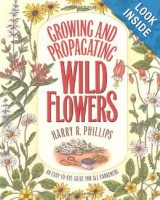 One of my favorite resources for designing with natives is Growing and Propagating Wild Flowers by Harry R. Phillips. Although published in North Carolina, most of the plants mentioned are native to our area as well. In addition to detailed information on propagation, the author offers plant lists for continual bloom through the seasons in sun, part sun or shade. For each plant featured, there are suggestions for good companion plants that like the same conditions.
One of my favorite resources for designing with natives is Growing and Propagating Wild Flowers by Harry R. Phillips. Although published in North Carolina, most of the plants mentioned are native to our area as well. In addition to detailed information on propagation, the author offers plant lists for continual bloom through the seasons in sun, part sun or shade. For each plant featured, there are suggestions for good companion plants that like the same conditions.
I hope readers will share ideas on creating a pleasing landscape with native plants. While the birds and butterflies don’t seem to care about our human aesthetic sense, our human neighbors do. If we can make people go “Ah…”, we might end up with more plants in the neighborhood that are pleasing to our avian friends.


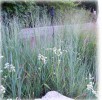

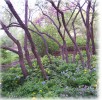
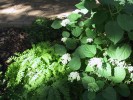
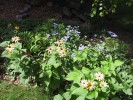

Great posting, Betty, with lots of useful info and a resource for more. We need to be cognizant of design features when planting natives in our front yards.
I agree with Ed, your article is well written and informative.
I share your angst over wild gardens getting more wild than anticipated or desired. Your suggestion to limit choices in an area is one I will definitely try. With age and arthritic hands and knees I need to develop a garden requiring less hands-on and more time for enjoyment! Thanks so much!
Thanks Betty
It is always a struggle to keep things looking organized.
It may be the most difficult part.
Maybe we should tour each others yards to see things with different eyes and make suggestions to each other. Where I see things in my yard that are all natives and it seems purposeful to me, I think my neighbors see it differently.
Your pictures were good examples.
Kathy Bildner
Thanks for the positive feedback. Ed, in November we have typically shared gardening stories from the year. Maybe we could ask members to share a story about a design that inspired them or someone they know to plant natives.
Good article, Betty, and beautiful combinations.
The primary colors of Celandine Poppy, Bluebells, and Wild Geranium with the Wild Plum and the Redbuds are so easy on the eyes. The splashes of color with the tall grassed feels so balanced.
In my yard, Sweet Coneflower grows over 4″ tall, and I have seen Rattlesnake Master that tall as well. Are those two plants in your examples young or were they cut back?
Thank you for the insights.
The sweet coneflower is in a relatively dry spot — I think that kept it shorter. I need to try cutting them back but never think of it at the right time!
A keeper article. Thank you and thank you to Mitch Leachman for notifying Audubon Members. Keep up the inspiring work.
Hi, just saw this great post. I am planning this fall to remove several beds of daylilies from my backyard garden, and choosing what natives to plant instead. I have a list of about 20 that I’m interested in, but I don’t know if I should plant a little of everything or bigger masses of fewer species. I’m not worried about the neighbors (my garden has a high fence) but rather what will work best for the plants and insects and animals. The plants I’m interested in all like the same sort of sun and water, in general, but I figure some will be happier than others, so even if I plant everything I assume some will spread and some will die out, but I don’t know if I should be so Darwinian from the start. If anyone has any advice or opinions I’d love to hear them Thanks!